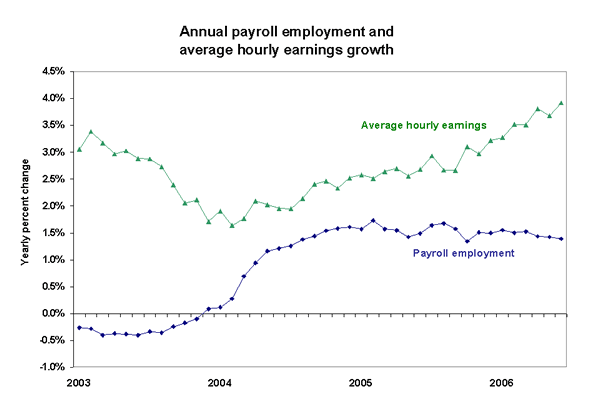July 7, 2006
Slow job growth in second quarter reflects pace of overall economy
by Jared Bernstein with research assistance from Yulia Fungard
For the third month in a row, the nation’s employers hired fewer workers than analysts expected, providing another month of evidence that the American job machine has downshifted. During the second quarter of the year, payrolls grew by 108,000 per month, well off the previous quarter’s monthly rate of 176,000, and the slowest quarter since 2003Q3 (when the economy finally pulled out of the jobless recovery). According to today’s report from the Bureau of Labor Statistics, the private sector added only 90,000 jobs last month—86,000 per month over the quarter—a clear sign that the economy is generating less labor demand.
The unemployment rate held steady at 4.6%, and wages were up 0.5% hourly and 0.8% weekly, reversing May’s much weaker wage results. Over the past year, wages are up 3.9% hourly, the fastest growth rate since June 2001; with the advance in average weekly hours, weekly earnings are up 4.5% over last year, their highest rate since February 1998.
Why is employment growth slowing while wage growth has been accelerating, and how might the Federal Reserve react to these opposite trends? The slower growth in jobs is most likely due the same headwinds responsible for slowing down the overall economy: higher interest rates, the cooling housing market, and high energy costs.
An important hint from today’s report, for example, shows that employment in residential construction fell 6,800 over the past two months, the sector’s first back-to-back monthly losses since the spring of 2001. Thus far this year, residential construction employment is up 7,000, compared to an increase of 20,000 over the same six-month period last year. And while employment in real estate was up 5,000 last month, job growth among credit intermediaries and insurance carriers—so-called “downstream industries” from the housing sector—-has been notably flat over the past few months. In other words, there are many connections between the housing sector and other sectors in the job market, and the cooling of that sector has far-reaching implications.
Changes in wages, on the other hand, tend to occur more gradually. That is, it takes a while—at least half of a year—for the momentum from the job market to begin to reach and effect wage trends. The chart below compares year-over-year growth rates in payroll employment to nominal hourly wages. Though employment began to accelerate in 2003, wages continued to grow more slowly until 2004, and did not accelerate much until the spring of 2005. In that regard, if the current slowdown in job growth sticks, we can expect wage growth to follow suit by declining sometime early next year.

Given its anti-inflation tilt, the Fed may choose to target the faster wage growth rather than the slower job growth. However, given the delayed reaction times shown in the chart above, the Fed should reasonably worry less about wage-push inflation (energy, not labor costs, has been the major factor behind price increases anyway), and pause in their rate-hike campaign in hopes of boosting lagging labor demand.
As for the manufacturing sector, employment was up 15,000 last month, more than reversing May’s 8,000 job decline. While job growth in the overall sector has been choppy of late—one month up, the next month down—durable manufacturing, lead by machinery, metal products, and electrical equipment (but not by auto production), is up 79,000 over the past year; non-durable employment is down 61,000, led by losses in apparel and textiles.
Retailers also shed 7,000 jobs last month, led by a large 14,000 decline in general merchandisers. Employment is down 80,000 in retail this year, reflecting a general weakening in sales in recent months, and also perhaps a decline in hiring needs due to increased Internet purchases.
Household survey results regarding employment growth were again far more positive than those of the more reliable payroll survey discussed above. In fact, given its much larger sample size and less error-prone monthly estimates, the vast majority of analysts—the Federal Reserve, the president’s Council of Economic Advisers, financial market economists—favor the payroll survey for the actual number of jobs gained or lost each month.
However, monthly results on rates from the household survey tend to be much more reliable than the “counts” In the payroll survey. The household survey’s unemployment rate remains low, at 4.6%, and though labor force participation ticked up a tenth of a percentage point to 66.2%, it is still down from the peak levels reached in the latter 1990s (e.g., 67.1% in 1998). This suggests that the low unemployment rate derived from the survey is probably overstating to some degree the actual tautness of the job market.
Another positive result from the household survey is the marked decline in long-term unemployment. The share of the jobless without work for at least six months fell to 16.2%, the lowest rate since March 2002.
Summarizing, June’s employment report added yet another month to a trend toward slower job growth that began earlier this year. The slowdown appears rooted in the same growth-dampening forces found in the overall economy, and in that sense, this cooling is likely to persist. While wages have accelerated of late, they are only now catching up to recent inflation rates, meaning workers’ purchasing power is up only slightly (and still well below productivity growth). Moreover, the inherent lags in the employment/wage relationship suggest that, if the current slowdown in job growth continues, wage growth will also slow in coming months.
To view archived editions of JOBS PICTURE, click here.
The Economic Policy Institute JOBS PICTURE is published each month upon release of the Bureau of Labor Statistics’ employment report.
EPI offers same-day analysis of income, price, employment, and other economic data released by U.S. government agencies. For more information, contact EPI at 202-775-8810.
